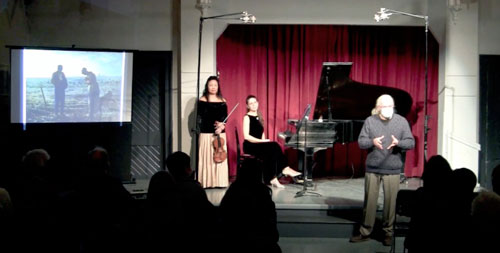
Watch on YouTube
$30 for 5 day pass
You need a Gmail account to register
We will send you the Youtube link to your Gmail account within 24 hours.
Please eTransfer $30 to
ticket@CanadianSinfonietta.com
Questions? Please email Ben@CanadianSinfonietta.com
Duo Recital
Saturday, November 27th, 2021
Heliconian Hall
35 Hazelton Ave, Toronto
PROGRAM
Antonin Dvorak: Romantic Pieces, Op. 75
I Allegro moderato
II Allegro maestoso
III Allegro appassionato
IV Larghetto
Stuart Beaudoin: “Angelus”, World Premiere
Johannes Brahms: Sonata No. 1 in G Major, Op.78
I Vivace ma non troppo
II Adagio
III Allegro molto moderato
Tomaso Vitali: Chaconne in G Minor
Stu Beaudoin, MA, ARCCO, MSMus has been a church organist and music director since 1978. Stu has a keen interest in the theology of music and is a fan of Hildegard of Bingen.
Stu has directed choir and orchestra throughout his career and in 2004 founded a chamber choir, Cantorei sine Nomine, to sing Buxtehude and earlier music. He also established the Orpheus Symphonietta which performs with the choir and also each Remembrance Day.
Stu has retired from church music to focus on composition. This has led to a violin concerto, orchestra elegies, 2 string quartets, 8 organ sets and ‘Canoe Dancing’ a multimedia work for 10 winds, pictures and dance. His ‘Fantasia on Jehous Ahatonia’ for organ won the John White Memorial competition in 2017 and his Elegy for Orchestra placed 3rd in the International Music Festival of Toronto in 2019. The Angelus, premiered today, was First Prize in the International Music Festival and Competition in 2021.
Angelus for Violin Solo and Strings
The inspiration for Angelus is the need for Peace and Tranquility in times of COVID. I carried in my mind the peasant boy and girl, praying at close of day, in Millet’s famous painting. The painting gives a wonderful sense of spiritual light and shadow, peace and fulfillment, and you can imagine them singing the Angelus at hearing the church bell at 6pm.
The ‘Angelus domini nuntiavit’ chant is a blessing from Gabriel as he greets Mary, the mother of Christ prior to the conception. If there is a story here, it is the searching and coming of the angel to Mary, the work day dance and then the prayer. The tone of the angel greeting pervades the music. After the working dance there is a pause for the soloist to prepare for prayer.
The music of the prayer is actually the chant ‘Angelus domini descendit’ in which the angel at the tomb greets Mary Magdelen with the announcement of the resurrection. The same tranquility in the garden is met in this prayer. I have not tried to imitate the ‘Angelus…nuntiavit’ chant although you would be pressed to separate them. The first phrase of the ‘Nuntiavit’ sounds like an inversion of the ‘descendit’ chant, a most appropriate melody. The chant for ‘descendit’ is stated in augmentation and diminution for the prayer.
Although it is purely an organizational device, it seems appropriate that the opening prayer be the greeting of the virgin and the closing prayer be the resurrection of the Son.
The key of the music is actually a mixed mode (Eb, F, G, Ab, Bb, Cb, Db) which is used rigorously throughout the piece including the mode transposition at bar 174.


